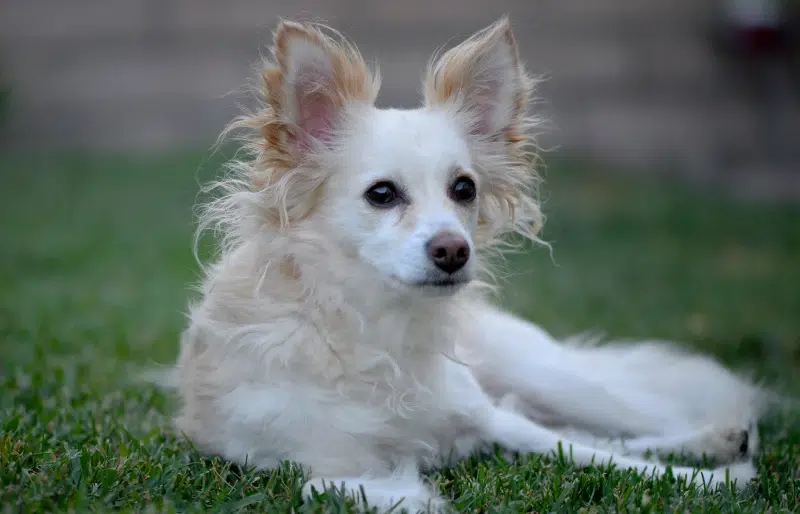Click Below to Skip Ahead
Blending two breeds with unmistakable looks and some of the canine kingdom’s most spirited personalities will undoubtedly result in a one-of-a-kind cross. That’s precisely what you get in the Papshund, which is a spritely Dachshund Papillon mix!
Papshunds highlight the best characteristics of their parent breeds. If you want to adopt one of these marvelous mixes, we’ll discuss the details of Papshund care and why these adorable dogs deserve your attention.
Breed Overview
Height:
9–11 inches
Weight:
10–18 pounds
Lifespan:
12–16 years
Colors:
White, black, brown, fawn, red, sable, wheaten, wild boar
Suitable for:
Families with older children, people in apartments, seniors
Temperament:
Loving, intelligent, eager to please, energetic, friendly, sensitive
The Papshund combines two small yet eye-catching breeds: the Papillon and Dachshund. With the Papillon’s butterfly ears, the Dachshund body, and a mix of coat types, the toy hybrid can look almost like an extra-long Chihuahua or PomChi. This endearing hybrid packs plenty of personality into their diminutive frame.
Papillons come from high society. The noble lap warming dogs date to 16th century France and Spain, appearing as crosses from toy dogs and Spaniels. Originally called the Dwarf Spaniel, they were frequent subjects of Renaissance artists. Despite the privileged pedigree, Papillons have the intelligence, biddability, and talent of the best herding and hunting dogs.
Dachshunds are hard-nosed German hunting dogs, appearing around the same time but on a different side of the tracks. With a look unlike any other, the features that make them familiar are all intentional. Rather than point, set, or retrieve, the Dachshund (meaning “badger hound”) used its squat body to track and single-handedly fight game in burrows. They’re companions now, but the fierce drive that made them hunting successes is apparent in today’s Doxies.
Papshund Puppies
Papshund puppies are irresistible, especially when they inherit the Papillon’s perked ears and the Doxie’s short legs. Since they are a mix, their look varies significantly depending on which genes they express. Physical features aside, Papshund puppies are reliably energetic and curious and need early training and socialization.
Finding a Papshund isn’t overly challenging. Papillons and Dachshunds are the 51st and 9th most popular purebred dogs in America, respectively, and the Papshund is recognized with five mixed breed registries. Despite limited breeders, these designer hybrids are frequently advertised for adoption online and in shelters.
Searching for “Papshund” should yield nationwide results on sites like PuppyFinder or DogsNow. Alternatively, a search for “Papillon” on adoption networks like Petfinder or Adopt a Pet will include Papshunds.
Adopting through these channels is convenient but risky. Sellers should show good communication and have an established reputation. Unsecured and up-front payments are typical red flags, and you should have the opportunity to meet the dog before buying.
Even when the seller has a legitimate puppy, they may have undisclosed health problems. To avoid these issues, start with local searches in ads and shelters where you can meet and better vet your potential pet.

Temperament & Intelligence of the Papshund 🧠
The Papshund is an energetic, upbeat, and affectionate dog. They’re adaptable to city and rural life and don’t require much space or outdoor activity. All they want is a deep bond and abundant love from their owners.
Alongside their small size, the Papshund’s intelligence makes them a relatively easy pet for first-time owners. Papillons are winners on almost every level. They have a desire to please and sociability that makes housebreaking and training effortless. The independent Dachshund adds some unpredictability and cheekiness to the mix, but they catch on quickly with consistent, positive training.
Are These Dogs Good for Families? 🏡
A Papshund’s lovability and devotion are a delight for attentive families. They’re sweet, gentle, and playful with kids. Although their delicate bodies are a concern around young children, they thrive among family members with whom they can forge strong bonds.
They stay active and ever-ready for play but are equally willing to snuggle. Following their family is their greatest joy, and having several people to engage them will help this sensitive dog stave off loneliness and separation anxiety.
Though they aren’t the best working dogs, a Papshund can be a quality watchdog due to their alertness and propensity for barking. They can be territorial and wary of outsiders, and their courage ensures they’ll rarely back down from a perceived threat.
Fortunately, they’re also astute and can quickly adapt their tolerance toward strangers. With socialization, they are extremely friendly and can effortlessly get along with people and animals.
Does This Breed Get Along With Other Pets? 🐶 😽
Papshunds get along well with other dogs with early, slow introductions and frequent socialization. Having another pet can benefit them when you’re away from home to stave off stress and undesirable behaviors.
The Dachshund can lend a high prey drive that can be troublesome for smaller animals, but they generally don’t have trouble with other pups in the house.
Things to Know When Owning a Papshund
The Papshund breed makes ownership relatively easy. They travel easily by plane or car, and finding a pet-friendly hotel that allows them is rarely a challenge. Care is minimally demanding, as they need little space, material possessions, or food. Still, all dogs have unique needs that you must understand if you hope to keep them healthy, happy, and obedient.
Food & Diet Requirements 🦴
Papshunds only need about a cup of food daily. Monitoring feeding and activity is critical to prevent obesity. A high-quality dry dog food rich in proteins, fats, carbs, vitamins, and minerals is the surest way to ensure they receive proper nutrition.
Since Papshunds mature quickly, you can usually switch from puppy to adult food after 7–9 months. Work with your vet if you’re uncertain when to switch to different foods according to your dog’s life stages.
Exercise 🐕
Even though they have seemingly boundless energy, the daily exercise needs for a Papshund aren’t extreme. At their size, 30–45 minutes of vigorous exercise will be enough to tire them out. Take walks around the block, or socialize your dogs while they run about at a dog park. Daily workouts aren’t intense, but they are critical to prevent excess weight from stressing their fragile frames.
A fenced-in yard to play fetch or chase them around is ideal, though any time outside requires close supervision. Papshunds are likely to run off or escape under a poorly established fence. Being toy dogs, they are also at greater risk of predation by wild animals.
Training 🦮
The Dachshund’s influence adds a bit of testiness to the trainable Papshund. While they’re generally eager to please and easy to teach, their prey drive and desire to roam can make areas like leash training more frustrating.
Resource guarding may be a problem, requiring training and environmental changes. Otherwise, house training and obedience training are relatively straightforward with this intelligent hybrid, even for inexperienced owners.
Papshunds are sensitive and respond best to positive reinforcement and rewards. They need constant training to promote good behavior. Crate training is an excellent way to housebreak your puppy and help them get used to a routine. Papshunds have smaller bladders and will require close care during potty training. Although they’re relatively biddable and friendly, early training and socialization are no less critical for Papshunds than any other dog.
Grooming ✂️
Papshunds are moderate shedders. Their medium-length, soft hair requires 1–2 weekly brushings with a slicker and pin brush to detangle and maintain a healthy coat. The long hair in their large ears makes frequent checks and cleanings necessary to prevent dirt buildup and infections.
Using an ear wash or wipes frequently, brushing their teeth at least once weekly, and performing monthly nail trims round out the grooming routine. Early, positive introductions to grooming are crucial in keeping your Papshund stress-free and cooperative.
Health and Conditions ❤️
Papshunds are relatively robust designer dogs, with many living over 16 years. Although crossing purebred Papillons with Dachshunds might lessen the chance of inheriting unique diseases from either parent, receiving health history and parent information will ensure your dog is healthy. Unfortunately, this isn’t always easy. Many Papshunds are adopted, and those reports are often unavailable outside reputable breeders.
Regardless of their genetic dispositions, the Papshund’s build makes them prone to various physical problems. Intervertebral disc disease, for instance, is a common issue for their long backs, a trait they can inherit from the Dachshund. A disc injury can occur from hard impacts. Enhancing the environment with ramps, baby gates near stairs, and other accommodations is essential in preventing your dog from jumping long distances that may cause trauma.
- Patellar luxation
- Ear infections
- Cataracts
- Glaucoma
- Progressive retinal atrophy
- Obesity
- Intervertebral disc disease
- Diabetes
Male vs Female
Male Papshunds are usually larger than females, and although there aren’t any proven personality differences, anecdotal evidence points to some contrast in temperaments. Many owners find males to be more outgoing, eager to please, and affectionate, often to the point of clinginess.
Females are more independent and reserved. These differences are not guaranteed, and desexing will iron out many gender-specific behaviors.
3 Little-Known Facts About the Papshund
1. Papshunds Don’t Have Much Doggy Odor
While every dog can stink when they roll around in filth, some are less prone to naturally bad odors. Dachshunds and Papillons don’t have an undercoat typical of smellier dogs. As they aren’t avid swimmers, they also tend to produce less oil from their sebaceous glands, which is a key contributor to that doggy stench. With a lower likelihood of smelling, Papshunds don’t need more than a few baths throughout the year.
2. Dachshunds Add Loads of Variety to the Mix
The Papillon and Dachshund come in several colors, adding significant range to the Papshund’s coat. But the Dachshund breed brings more variation than most dogs. They have two sizes, a standard and a miniature, that can substantially affect the Papshund’s size.
Plus, they can have smooth, wire-haired, or longhaired coats. Alongside the coat variation, some believe these three Dachshunds also have different personalities.
3. Papshunds Excel at Agility
Finding a fitting competitive sport for your Papshund allows you to bond, socialize, and exercise with your pup. Papshunds are game for almost anything, and one of the best places to test their mettle is in agility.
Dachshunds seem an odd match, but agility is an excellent outlet for these tenacious doggies, as long as you keep the jumps low to stay easy on the back. If your Papshund inherits more of the Papillon body structure, you may have an agility star in the making. Papillons are consistent agility winners. Even if you don’t plan to compete, setting up an obstacle course in the backyard will unleash their natural skills.
Conclusion
The cute, cuddly, and clever Papshund provides endless entertainment in a low-maintenance pet. Pet parents from all walks of life can appreciate, enjoy, and succeed with these marvelous dogs thanks to their trainability, intelligence, and temperament. Adopting a Papshund is a rare opportunity that any prospective pet parent should seriously consider when the timing is right.
Featured Image Credit: Steve Bruckmann, Shutterstock











